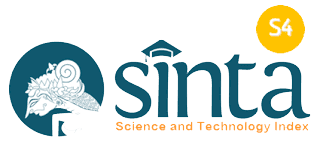The Effect of Motivation on Employee Performance at the Social Service, Manpower and Transmigration, Maros Regency, South Sulawesi, Indonesia
(1) 1Institute of Economic Science Wira Bhakti of Makassar
(2) Universitas Negeri Makassar
(*) Corresponding Author
DOI: https://doi.org/10.26858/pdr.v5i2.31877
Abstract
This study aims to determine the magnitude of the effect of motivation on employee performance at the Department of Social Affairs, Manpower and Transmigration Maros Regency . Theoretically, the results of this study are expected to develop scientific treasures and establish well-coordinated human relationships and roles in the field of human resources in the hope of making a contribution that leads to improving agency performance, through the application of motivation for social services, labor and transmigration in Maros Regency. The variables in this study are the motivational variable as the dependent variable, while the performance variable as the independent variable. The data collection technique uses observation and questionnaire methods as well as being the sample in this study as many as 53 employees. The results of this study indicate that partially the motivational variable has a significant positive effect, while simultaneous testing shows a significant positive effect on the performance of social service employees, labor and transmigration in Maros Regency. The coefficient of determination indicates that the ability of the independent variable to predict the influence of motivation has a moderate effect on employee performance. Therefore, it is necessary to pay attention to the provision of motivation by the leadership, especially the Head of the Social Service of Manpower and Transmigration in Maros Regency so that employees are more enthusiastic about working.
Keywords
Full Text:
PDFReferences
Arifai, M., Parawansa, A., Firman, M. J., & Aras, M. (2019). The Effect of Motivation and Leadership Behavior on the Performance of Employees of the Industry and Trade Service in Makassar City. International Conference on Public Organization (ICONPO).
Berampu, L. T., & Sari, W. D. (2020). Human Resources Transformation in the Digitalization Professional Era in North Sumatera. Esensi: Jurnal Bisnis Dan Manajemen, 10(2), 135–146.
Brewster, C., & Söderström, M. (2017). Human resources and line management 1. In Policy and practice in European human resource management (pp. 51–67). Routledge.
Campbell, N., O’Driscoll, A., & Saren, M. (2013). Reconceptualizing resources: a critique of service-dominant logic. Journal of Macromarketing, 33(4), 306–321.
Cowling, A., & Mailer, C. (2013). Managing human resources. Routledge.
Ek, K., & Mukuru, E. (2013). Effect of motivation on employee performance in public middle level Technical Training Institutions in Kenya. International Journal of Advances in Management and Economics, 2(4), 73–82.
Farndale, E., Pai, A., Sparrow, P., & Scullion, H. (2014). Balancing individual and organizational goals in global talent management: A mutual-benefits perspective. Journal of World Business, 49(2), 204–214.
Gagné, M. (2018). From strategy to action: transforming organizational goals into organizational behavior. International Journal of Management Reviews, 20, S83–S104.
Jeeva, A. S. (2012). MRO Procurement: Best Practices Framework for Capital Equipment. In Contemporary Issues in Mining (pp. 69–79). Springer.
Jurchak, M., Grace, P. J., Lee, S. M., Willis, D. G., Zollfrank, A. A., & Robinson, E. M. (2017). Developing abilities to navigate through the grey zones in complex environments: Nurses’ reasons for applying to a clinical ethics residency for nurses. Journal of Nursing Scholarship, 49(4), 445–455.
Katz, R. (2014). Empowerment and synergy: Expanding the community’s healing resources. In Studies in empowerment (pp. 201–226). Routledge.
Khan, M. A., West, S., & Wuest, T. (2020). Midlife upgrade of capital equipment: A servitization-enabled, value-adding alternative to traditional equipment replacement strategies. CIRP Journal of Manufacturing Science and Technology, 29, 232–244.
Kotlar, J., De Massis, A., Wright, M., & Frattini, F. (2018). Organizational goals: Antecedents, formation processes and implications for firm behavior and performance. International Journal of Management Reviews, 20, S3–S18.
Manara, D. F., Villa, G., & Moranda, D. (2014). In search of salience: phenomenological analysis of moral distress. Nursing Philosophy, 15(3), 171–182.
Nimon, K. (2011). Improving the quality of quantitative research reports: A call for action. In Human Resource Development Quarterly (Vol. 22, Issue 4, pp. 387–394). Wiley Subscription Services, Inc., A Wiley Company San Francisco.
Nino, M., Blanco, J. M., & Illarramendi, A. (2015). Business understanding, challenges and issues of Big Data Analytics for the servitization of a capital equipment manufacturer. 2015 IEEE International Conference on Big Data (Big Data), 1368–1377.
Okoye, P. V. C., & Ezejiofor, R. A. (2013). The effect of human resources development on organizational productivity. International Journal of Academic Research in Business and Social Sciences, 3(10), 250.
Olusadum, N. J., & Anulika, N. J. (2018). Impact of motivation on employee performance: a study of alvanikoku federal college of eduaction. Sigma, 1(1).
Reinholt, M. I. A., Pedersen, T., & Foss, N. J. (2011). Why a central network position isn’t enough: The role of motivation and ability for knowledge sharing in employee networks. Academy of Management Journal, 54(6), 1277–1297.
Shahzadi, I., Javed, A., Pirzada, S. S., Nasreen, S., & Khanam, F. (2014). Impact of employee motivation on employee performance. European Journal of Business and Management, 6(23), 159–166.
Snell, S., Morris, S., & Bohlander, G. W. (2015). Managing human resources. Cengage Learning.
Suryani, F., Widiasanti, I., Satrio, D., Yunianto, A., Mulyono, T., & Luthfiana, Y. (2021). A dominant factor of human resources performance of construction management in supervising high rise building construction phase. IOP Conference Series: Materials Science and Engineering, 1098(2), 22038.
Article Metrics
Abstract view : 354 times | PDF view : 29 timesRefbacks
- There are currently no refbacks.
Copyright (c) 2022 Muh. Arifai, Muammar Muammar


































